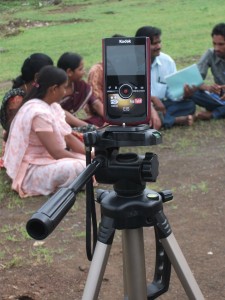“We learnt how to make a story. We never gave importance to the story before, but now we do.” – Jyotiben, trainer
“Even in the age of information overload, it is surprising that so little information is available on the tribals. So many histories- personal, political, oral, visual, gastronomic, medical, linguistic, are tucked away in little pockets of the country. During the Songadh trainings, I realized that these pockets are not the corners that they seem but entire horizons,” says Manish Kumar, senior Media Trainer and Program Manager at Video Volunteers. He recently returned, much enthused and contemplative, after wrapping an extensive training camp in video production and editing for the adivasi community in Songadh, Gujarat.
The training was organized by Video Volunteers in collaboration with the Shakti- Legal Aid and Human Rights Centre, Songadh, an NGO which works at the grassroots with the adivasis on several socio-economic, cultural, educational, political and religious issues. The project came together in the quest to set up a tribal arts and culture centre which will house, archive and display visual anthropological records of the adivasi communities’ lives and traditions. The proposed centre is the brainchild of Sannybhai, Managing Trustee of Shakti. He envisions the centre as a comprehensive resource of adivasi art, culture and way of life which bridges the past with the present and leads into the future. Speaking of the decision to collaborate with Video Volunteers, he says, “I was familiar with the organization’s work but when the idea of starting a cultural centre came up, it was Ingrid Beazely, our friend and well-wisher from London who suggested the tie-up.”
Source: Video Volunteers Trainings: The Adivasis of Songadh, Gujarat by Manish On October 6, 2011
Address : https://www.videovolunteers.org/video-volunteers-trainings-the-adivasis-of-songadh/
Date Visited: Fri Oct 24 2014 12:06:21 GMT+0200 (CEST)
More
“In less than 200 years, photography has gone from an expensive, complex process to an ordinary part of everyday life. From selfies to satellites, most of the technology we use and spaces we inhabit rely on cameras. […] While photographic documentation can aid in shaping history, it can also be a window into the horrors of the past.” – Read more or listen to Butterfly Effect 9 – The Camera on CBC Radio Spark 26 May 2023 >>
